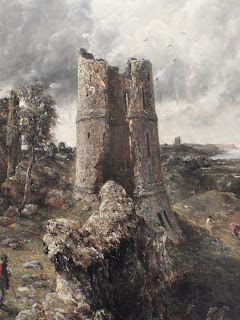Yale Center For British
Art
Again I am going to the museum with Dave; together we
walked in the misty overcast streets to the Center for British Art. Upon
entering the atrium, I was surprised by how large and barren the room was. The
ceiling went up several stories but nothing was on the walls the only things to
be seen were two statures. After we lingered at the two statues for a bit, we
ascended the stairs to the fourth floor.
“The Yale Center for British Art is a public art museum
and research institute for the study of British art and culture. Presented to
Yale University by Paul Mellon (Yale College, Class of 1929), the Center houses
the largest collection of British art outside the United Kingdom” (http://britishart.yale.edu/about-us).
“Paul Mellon (1907–1999) was one of the greatest art collectors and
philanthropists of the twentieth century. Born in Pittsburgh, he was the only
son of the financier, industrialist, and Secretary of the Treasury Andrew W.
Mellon, and his English wife, Nora McMullen. His childhood summers were spent
in the English countryside visiting his mother’s family, where his lifelong
love of British culture began” (http://britishart.yale.edu/about-us/paul-mellon-founder).
“The Yale Center for British Art was designed by the internationally acclaimed
American architect Louis I. Kahn (1901–1974). Located across the street from
his first major commission, the Yale University Art Gallery (opened in 1953),
the Center was Kahn’s final work and was completed after his death. It was the
first museum in the United States to incorporate retail shops in its design” (http://britishart.yale.edu/architecture).
On the whole I wasn’t
overly impressed, I found that most of the paintings were portraits, but don’t
get me wrong they were of masterful quality, but I just found them very plain
and uninspiring. There were a few paintings that just jumped out at me, they
were mostly the paintings of harbors, or landscapes, to me they were dramatic,
filled with movement, and had beautiful color pallets.
The picture that I feel
in love with was called, “Hadleigh Castle, The Mouth of the Thames – Morning after
a Stormy Night”. This painting caught my eye because of its moody atmosphere,
and after I continued to look at it I liked it more and more. My favorite part
of this painting is the larger tower, I love how the lighting hits the ruined remains
of the tower and the detail of the crumbling foundations. The subtle color in
the rock of the walls adds the perfect amount of aging. The high light and
shadows are placed masterfully on the tower and around the entire piece. This
painting was done by John Constable, he did this painting in 1829 oil on
canvas, this painting is of ‘the ruins of Hadleigh Castle that stands on the
northern shore of the mouth of the Thames. Constable had made drawings there in
1814, remarking in a letter that he was “always delighted with the melancholy
grandeur of a sea shore.” He was later moved to paint the view on a grand scale
by his grief over the death in 1828 of his wife, Maria. He was desolate and
depressed for the rest of his life, a ruin of a man, he called himself” (plaque
neck to painting). John Constable lived during 1776-1837.
John Constable’s painting fit into the movement of
Romanticism. “Romanticism was an artistic, literary, and intellectual movement
that originated in Europe toward the end of the 18th century and in most areas
was at its peak in the approximate period from 1800 to 1840. Partly a reaction
to the Industrial Revolution, it was also a revolt against aristocratic social
and political norms of the Age of Enlightenment and a reaction against the
scientific rationalization of nature. It was embodied most strongly in the
visual arts, music, and literature, but had a major impact on historiography,
education and the natural sciences. Its effect on politics was considerable,
and complex; while for much of the peak Romantic period it was associated with liberalism
and radicalism, in the long term its effect on the growth of nationalism was
probably more significant”, (http://en.wikipedia.org/wiki/Romanticism).
The movement to fallow Romanticism was Transcendentalism. “Transcendentalism is a philosophical
movement that developed in the 1830s and 1840s in the New England region of the
United States as a protest to the general state of culture and society, and in
particular, the state of intellectualism at Harvard University and the doctrine
of the Unitarian church taught at Harvard Divinity School. Among the
transcendentalists' core beliefs was the inherent goodness of both man and
nature. Transcendentalists believed that society and its institutions -
particularly organized religion and political parties - ultimately corrupted
the purity of the individual. They had faith that man is at his best when truly
"self-reliant" and independent. It is only from such real individuals
that true community could be formed”, (http://en.wikipedia.org/wiki/Transcendentalism).
So at the end of the day I left pleased, over all I found
many of the work to be uninspired, but yet many of them were wonderful pieces of
art. When we left there were many pieces that I found inspiring and flared my
imagination to life.









That's great that you made the connection between romanticism and American transcendentalism. Constables work certainly exhibits a romantic view of nature... that is in nature, we find sustenance and peace. Nature is not seen to be foreboding or dangerous...
ReplyDeleteIn the 19th century in America, Henry David Thoreau sought his version of peace and understanding by going to Walden Pond. He typifies the American transcendental movement.
Nice job!